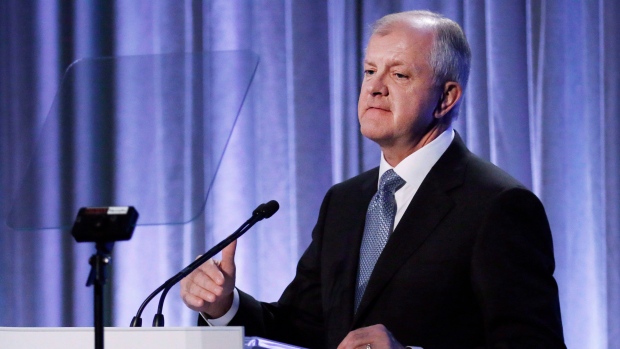Jun 19, 2017
Cenovus looks to soothe investors' nerves after Conoco deal backlash

Cenovus Energy (CVE.TO) Chief Executive Officer Brian Ferguson will attempt to soothe the nerves of investors burned by the near 50 per cent decline in the company’s stock price this year at the company’s investor day on Tuesday. The bulk of the declines in the company’s shares came in the wake of its $17.7-billion acquisition of ConocoPhillips’ (COP.N) oil sands assets on March 29, a deal that wreaked havoc on Cenovus’s previously pristine balance sheet.
The company was panned by investors over the price tag for the assets, which included Conoco’s 50 per cent stake in the Foster Creek–Christina Lake (FCCL) Partnership, which far exceeded the $12.7 billion Canadian Natural Resources (CNQ.TO) spent to snap up Shell’s (RDSa.N) Athabasca Oil Sands Project assets as super-majors beat a retreat from Canada’s oil sands. Cenovus’s acquisition also includes most of Conoco’s conventional assets in Alberta and British Columbia, and is forecast to result in an 18 per cent increase in adjusted funds flow per share in 2018, a key operating metric in the energy patch.
Front and centre for the company is deleveraging its balance sheet by selling non-core assets. Ferguson is targeting $3.6 billion worth of asset dispositions by year-end 2017 in a bid to pare the company’s debt load. Cenovus is taking bids on production equivalent to 45,000 barrels per day at a pair of legacy sites, Suffield and Pelican Lake. An update on those divestitures is expected sometime in the third quarter. The company has not identified other non-core assets it could put on the block, but RBC Equity Analyst Greg Pardy noted in a research report that implied production of 515,000 barrels per day in 2018 indicated total dispositions of assets producing 100,000 barrels per day.
UBS Analyst William Janela, who is among the most bearish on shares of Cenovus with a $12.50 price target, thinks the company will need to exceed street expectations on the pace of asset sales if it’s going to see substantial price appreciation. In a June 13 research note, Janela wrote that the onus is on management to execute, lest the shares languish in the near and medium term.
“We believe the burden is on [Cenovus] to over-deliver on timing and/or proceeds to provide a meaningful positive catalyst for shares – both of which become increasingly difficult at lower commodity prices,” he wrote. “We sense investors are looking for more immediate execution on initial asset sales in order to begin the process of de-levering.”
In spite of the carnage in the company’s stock price, Cenovus remains in good stead with the majority of the analyst community. The company has 14 buys, 12 holds and no sells, and the 12-month target price of $18.67 implies a 75.5 per cent upside for the share price in a year’s time.
Of further focus at the investor open house will be the company’s dividend policy after Cenovus was forced to slash its payout twice in the depths of oil’s swoon below US$30 per barrel. Cenovus currently pays out $0.05 per share on a quarterly basis, more than 80 per cent less than the $0.26 it doled out just two years ago. Ferguson has preached prudence surrounding the payout, telling analysts in February the company would be cautious on rapidly increasing the dividend after being caught in a tough spot during the market crash. UBS’s Janela hasn’t struck an overly optimistic view of the company’s dividend policy, as Cenovus has a number of competing causes for cash.
“Going forward, we expect dividend increases will compete more aggressively with growth capital as [Cenovus] balances shareholder returns with a need to fund development of its recently acquired Deep Basin assets,” he wrote. “Thus, we anticipate only nominal dividend raises (in absolute dollar terms) over the next few years and currently model a +$0.04/share increase to the annual dividend in both 2018-19.”
UBS is also warning the company may run into trouble if oil prices remain at these depressed levels, given Cenovus modelled its capital plans on West Texas Intermediate at US$50 per barrel.
“We believe a sustained period of sub-$45/Bbl oil prices (vs. its 2018-19 base case of $50/Bbl flat) would prompt [Cenovus] to curb growth spending in order to preserve capex/cash flow neutrality and defend its balance sheet,” Janela wrote.
Ultimately, while the company’s first investor day since June 2013 will provide further clarity on its plans, UBS doesn’t think it will be the catalyst for a rally.
“The investor day is a critical opportunity for the company to highlight its pro-forma outlook … and provide more granular detail on the acquired Deep Basin assets as well as updated project economics for future oil sands expansions,” Janela wrote. “However, we do not expect the investor day will serve as ‘the’ definitive catalyst to re-ignite interest in [Cenovus] shares, as we believe a stepchange in investor sentiment requires substantial execution on asset sales/debt reduction, a process we expect to be drawn out through [the second half of 2017.]”


